Fixes for Windows Stop Code Inaccessible Boot Device 💡
| ⚙️Complex Level | Low, Beginners |
| ⏱️Applies to |
|
| ✏️Fixes |
|
Causes of Windows Stop Code Inaccessible Boot Device
What does stop code inaccessible boot device mean? It simply means that Windows lost access to the system's partition during the reboot process, and hence the stop code - "inaccessible" boot device error appears. Here are a few reasons that might have caused the Windows 10/11 stop code Inaccessible Boot Device error:
- Drivers are faulty: Corrupted, outdated, or misconfigured drivers.
- Hardware conflicts: Usually caused by system updates or changes
- Hardware errors: A damaged hard disk.
- Malware and other causes.
In this comprehensive guide, Qiling Software delves into the intricacies of the stop code inaccessible boot device error and presents you with 13 quick fixes to help you regain control of your system. From troubleshooting basic issues to advanced remedies, we've got you covered. By understanding the underlying causes and implementing these effective solutions, you can steer your system away from the clutches of this vexing error.
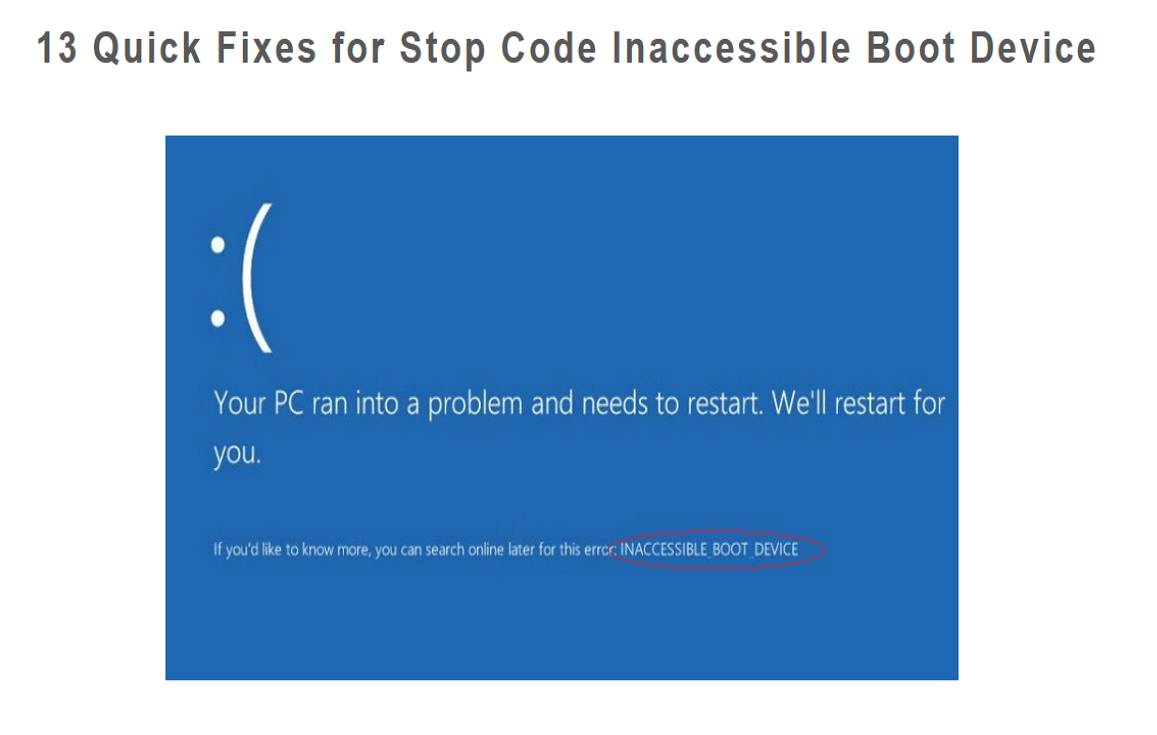
13 Quick Fixes for Windows 10 Stop Code Inaccessible Boot Device
Having laid the groundwork and grasped the importance of the 'stop code Inaccessible Boot Device' error, it is time to take action and explore the remedies. In the following parts, we will review 13 efficient solutions tailored to different situations.
These solutions aim to assist you in troubleshooting and overcoming this vexing problem. Given below are the 13 quick fixes for the 'stop code Inaccessible Boot Device' error:
Fix 1: Uninstall the Recently Installed Packages
One common trigger for the "Inaccessible Boot Device" error is a clash between newly installed software or updates and your system's existing configuration. To address this, we'll start with a fundamental step: uninstalling the recently added packages. This approach can often alleviate conflicts and restore your system's boot functionality. Use the following steps to uninstall the recently installed packages:
Step 1: To commence, open the Settings app using the "Win + I" keys and navigate to "Update and Security." Here, proceed to "Recovery" from the left sidebar, move to "Advanced Startup," and click on "Restart Now."
Step 2: After a short while, a blue screen will appear. Navigate to "Troubleshoot," then select "Advanced Options," and finally, "Command Prompt." Your computer will restart and boot into the Command Prompt application.
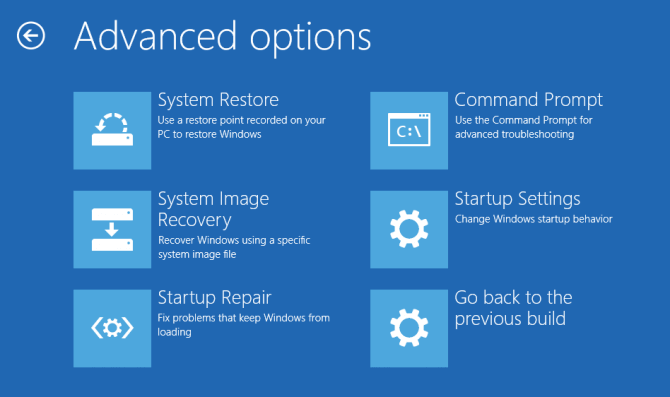
Step 3: Once Command Prompt is open, run the command "dir c:" (assuming Windows is installed on the C drive). Afterward, run the "Dism /Image:c:\ /Get-Packages" command to get access to all the installed packages. Utilize the date field to identify the most recently installed package, and take note of its complete name.
Step 4: To remove the package, enter the command "dism.exe /image:c:\ /remove-package /[package name]," replacing "[package name]" with the name you previously noted. Finally, complete the process by rebooting your machine.
You May Also Like:
Fix 2: Update Your Drivers
Outdated or incompatible drivers can often be the culprits behind the "Inaccessible Boot Device" error. To address this, we'll delve into the realm of driver updates – a crucial step to ensure your system components are harmoniously interacting. Below is the process of updating your drivers:
Step 1: Initiate the process by opening the Power User Menu. To do this, simultaneously press the "Windows" key and "X" key on your keyboard. Choose "Device Manager" from the appearing "Start Menu" menu.
Step 2: Locate the specific driver that is causing the problem. In most cases, the trouble may be attributed to the "Standard SATA AHCI Controller" under the "IDE ATA/SATA controllers" section. To access this, click on the driver to expand its details.
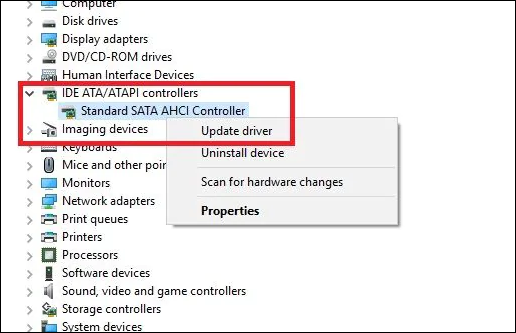
Step 3: Once you have the driver details expanded, proceed by selecting "Update Driver." Opt for the option labeled "Search automatically for drivers." This will enable the system to seek out the most up-to-date driver for your device.
Step 4: Follow the on-screen instructions for successfully updating the driver. After completing the driver update process, it is crucial to reboot your system. Restarting your system will ensure that the changes take effect and the updated driver functions optimally.
Fix 3: Run the BSOD Troubleshooter
Within Microsoft's Windows operating system, a useful utility has been integrated to effectively address a range of Blue Screen of Death (BSOD) errors, notably the troublesome "stop code Inaccessible Boot Device" error.
The BSOD Troubleshooter is capable of autonomously identifying and resolving potential culprits behind the occurrence of this error. Here's the procedure for utilizing this tool:
Step 1: Begin by accessing your system's settings. You can achieve this by clicking on the "Start" menu and selecting the gear-shaped "Settings" icon. Within Settings, find and click on the "Update & Security" option to proceed.
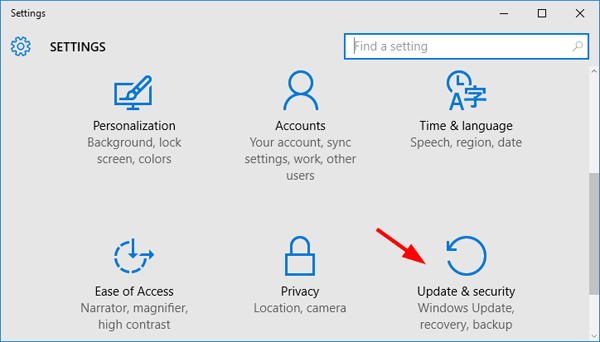
Step 2: Within the "Update & Security" section, navigate to the left-hand panel, where you'll find the "Troubleshoot" option. Among the troubleshooting options, locate and click on "Blue Screen." After selecting the "Blue Screen" option, you'll see the "Run the troubleshooter" button.
Step 3: Click on this button to initiate the troubleshooting process. The troubleshooter will systematically analyze the blue screen issue and attempt to identify its root cause. Once the troubleshooter completes, "Restart" your PC.
Fix 4: Enable AHCI Mode in BIOS
The Advanced Host Controller Interface (AHCI) mode in your system's BIOS (Basic Input/Output System) governs how your storage devices communicate with the operating system. Sometimes, the "Inaccessible Boot Device" error can be attributed to a conflict between the storage mode and your system's configuration. Enabling AHCI mode can often alleviate this issue. Here's how to do it:
Step 1: Reboot your computer and press the BIOS key to enter BIOS settings. The key differs for different models and brands and could be "Esc," "F2", "F12", "F8," or "Delete." Once you've successfully entered the BIOS interface, navigate to the section labeled "Main/Advanced/System Configuration."
Step 2: Within the "Main/Advanced/System Configuration" tab, locate the option named "SATA Mode." Adjust the setting for this option to "AHCI." After making this configuration change, save your settings within the BIOS and exit the interface. Proceed to reboot your system and see if the issue is resolved.
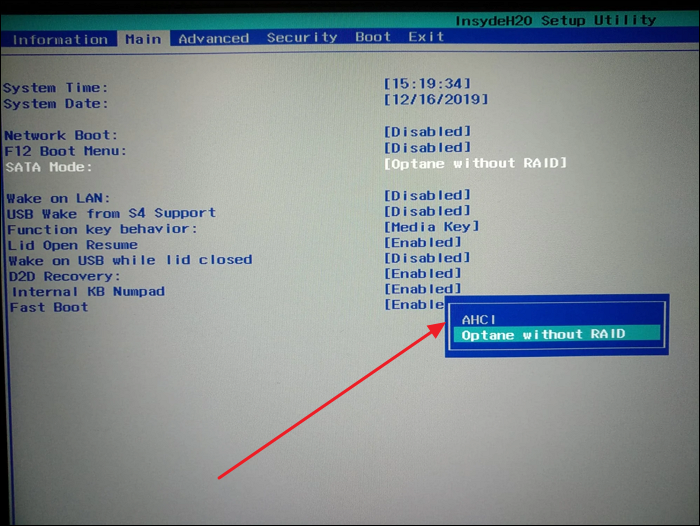
Fix 5: Run DISM Command
When system files become corrupted or are missing, it can lead to the "Inaccessible Boot Device" error. The Deployment Imaging Service and Management Tool (DISM) is a built-in Windows utility that can help repair and restore these crucial system files. The detailed steps to run the DISM command are following:
Step 1: Use the Windows search bar to look for "Command Prompt," once it appears, click "Run as administrator." In the Command Prompt, type the following command and press Enter:
DISM /Online /Cleanup-Image /RestoreHealth
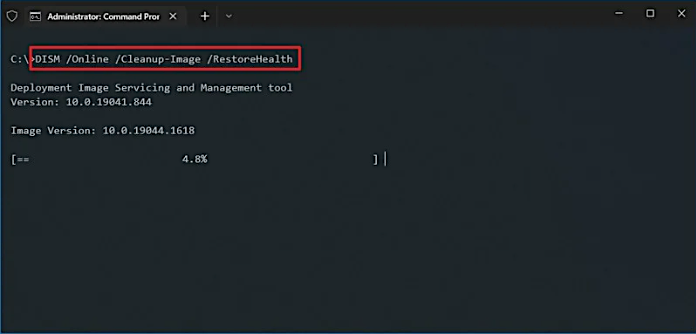
Step 2: The DISM tool will scan your Windows installation for issues and attempt to repair any corrupted files. It will take some time to scan and repair the system. Be patient and allow it to complete the process.
Fix 6: Run the SFC Scan
System files are the backbone of a stable Windows operating system. If corruption or inconsistency in these files is contributing to the "Inaccessible Boot Device" error, a System File Checker (SFC) scan can come to the rescue. The SFC scan is designed to identify and repair problematic system files. Let's proceed with this essential troubleshooting step:
Step 1: Launch Command Prompt as an administrator using the "Start" menu on your Windows. Once it is open, run the command "sfc /scannow" to fix the issue.
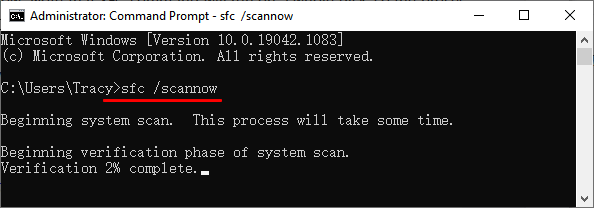
Step 2: The SFC scan will take some time to complete. Allow the scan to finish, and do not interrupt the process. Once the SFC scan is done, restart your computer and check if the "Inaccessible Boot Device" error is resolved.
Read Also: SFC scannow There is a system repair pending
Fix 7: Remove "Update Pending" Packages
Windows updates can sometimes introduce conflicts that result in the "Inaccessible Boot Device" error. If you suspect a pending update might be causing the issue, it's important to address it promptly. To remove "update pending" packages, you will need to follow these steps:
Step 1: Begin by opening the Windows menu and selecting "Settings." From there, go to "Update & Security," then "Recovery." Under "Recovery options," locate and click "Advanced startup." Here you need to click "Restart Now." Doing this will initiate the Advanced startup procedure.
Step 2: As your system restarts, you'll be presented with various troubleshooting options. Select "Troubleshoot," followed by "Advanced options," and finally, "Command Prompt." Once the Command Prompt window appears, run the following command:
reg load HKLM\temp c:\windows\nystem32\config\noftware\nreg
Step 3: The next thing you need to do is run the "reg delete "HKLM\temp\Microsoft\Windows\CurrentVersion\Component Based Servicing\SessionsPending"/v Exclusive\nreg" command. Continue to run the command "reg unload HKLM\temp" to continue with the process.
Step 4: Now, let's address pending updates. Type dism /image:C:\ /get-packages in the Command Prompt and hit Enter. This will generate a comprehensive list of updates, and you should make a note of any entries marked with the "Install Pending" tag.
Click the buttons below to share this article and let more users know about these fixes.
Step 5: To further streamline the process, it's prudent to create a dedicated temporary storage location for pending packages. Type MKDIR C:\temp\packages and press Enter. This will establish the necessary directory.
Step 6: Finally, the last step involves moving the pending packages to temporary storage. Input the command deism/image:c:\ /remove-package /packagename:[package name] /scratchdir:c:\temp\packages and press Enter. Replace [package name] with the accurate package name from the list you noted earlier.
Fix 8: Disable or Update Any Antivirus Software
While antivirus software is essential for protecting your system, it can sometimes conflict with system processes and lead to the "Inaccessible Boot Device" error. If you suspect your antivirus software is the culprit, consider disabling or updating it to resolve the issue.
Balancing security with system stability is crucial, and addressing potential conflicts between antivirus software and your operating system can contribute to a smoother computing experience.
Fix 9: Check the Hard Drive
A malfunctioning or failing hard drive can be a root cause of the "Inaccessible Boot Device" error. It's important to thoroughly assess your hard drive's health and integrity. Here's how to do it:
Step 1: Get your PC restarted in "Advanced Startup" through "Recovery" in Windows "Update and Security" settings. Now access "Command "Prompt" through "Advanced Options" in "Troubleshoot."
Step 2: When in the Command Prompt, run the command "bootrec.exe /rebuildbcd" and follow it by running the command "bootrec.exe /fixmbr." Finally, execute the command "bootrec.exe /fixboot" to fix this issue.
Fix 10: Enter Safe Mode
When facing the "Inaccessible Boot Device" error, accessing Safe Mode can provide a secure environment to troubleshoot and potentially address the issue. Safe Mode loads only essential drivers and services, minimizing the chances of encountering the error. Here's how to enter Safe Mode:
Step 1: Commence by pressing the "Power" button to initiate your system, then press it again to power down. You need to repeat this particular process twice or thrice consecutively. This iterative action will trigger the Automatic Repair feature.
Step 2: Once Automatic Repair is activated, navigate to "Advanced Options." To navigate, tap "Troubleshoot" and follow it by pressing "Advanced Options." Here access "Startup Settings," and upon reaching this point, select the "Restart" option.
Step 3: Upon system restart, press the "4" key. This input will facilitate entry into Safe Mode within the Windows 10 operating system. In Safe Mode, your system will launch with only essential drivers and functionalities, allowing you to diagnose and potentially resolve the issue at hand.

Fix 11: Perform Windows 10 Reset
When all else fails and the "Inaccessible Boot Device" error persists, performing a Windows 10 reset can be a drastic yet effective measure to resolve complex system issues. This process reinstalls Windows while preserving your personal files, settings, and apps. Here's how to perform a Windows 10 reset:
Step 1: Repeatedly turn on and off your computer using the Power button until "Automatic Repair" gets activated, and tap the "Advanced Options" button. Now click "Troubleshoot" and follow it by tapping "Reset This PC."
Step 2: Next, you need to click "Keep my files" and afterward follow the on-screen guidelines to reset your Windows 10 PC.
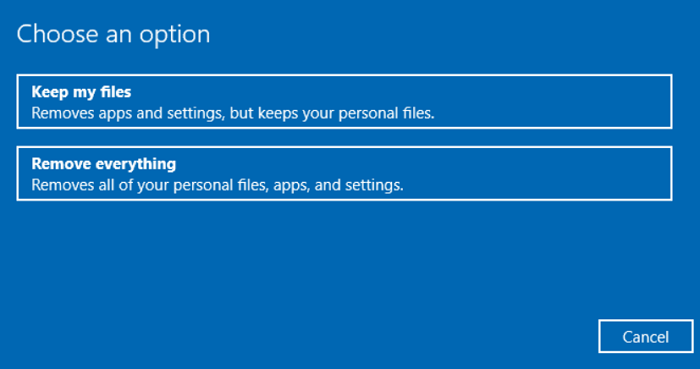
Fix 12: Check for Faulty Hardware
When facing persistent and elusive errors like the "Inaccessible Boot Device," it's important to consider the possibility of faulty hardware components. Hardware issues can play a significant role in causing such errors.
Checking for faulty hardware is a critical step in troubleshooting the "Inaccessible Boot Device" error. A malfunctioning component can undermine the stability of your system, and addressing hardware issues can help restore seamless functionality.
Fix 13: Reflash BIOS
In rare cases, the "Inaccessible Boot Device" error may be linked to an outdated or corrupted BIOS (Basic Input/Output System). Reflashing or updating the BIOS can sometimes alleviate this issue. However, it's important to approach this step cautiously, as improper BIOS updates can lead to further complications.
Reflashing the BIOS is a significant step that should be taken with caution. It's important to follow the manufacturer's instructions precisely and ensure that you're using the correct BIOS update for your specific motherboard model.
Fix Stop Code Inaccessible Boot Device Using Third-party Software
If you have trouble resolving the "Stop Code Inaccessible Boot Device" error, you can go for a third-party tool. You'll find that these tools can provide a convenient alternative for users who may not be well-versed in the intricacies of computing. One such tool that stands out is Qiling Disk Master, offering a comprehensive set of features designed to streamline the process of diagnosing and repairing boot-related issues.
Among its array of capabilities, Qiling Disk Master introduces a dedicated boot repair feature. This feature has undergone extensive research and development, resulting in an enhanced algorithm meticulously crafted to address a wide array of boot problems. This algorithm draws from a comprehensive knowledge base of various boot errors, including the notorious "Inaccessible Boot Device" stop code.
Qiling Disk Master isn't just a one-trick pony. It offers a toolkit that extends beyond boot repair, allowing you to effortlessly rebuild MBR and fix other related boot errors.
What Causes Stop Code Inaccessible Boot Device Error
Understanding the underlying causes of the " stop code Inaccessible Boot Device" error is paramount in unraveling its enigma. Delving into the intricacies of this stop code, we uncover a web of potential culprits that can disrupt the harmonious symphony of your system's boot process.
1. Drivers are Faulty
One of the key triggers of the "Inaccessible Boot Device" error lies in the realm of drivers. Incompatible or outdated drivers, especially those associated with critical system components, can send ripples of instability through your system's boot routine.
2. Hardware Conflicts
The delicate ballet performed by the myriad hardware components within your computer can sometimes be disrupted. When conflicting hardware components vie for supremacy over resources, the stage is set for the "Inaccessible Boot Device" error to take center stage.
3. Hardware Errors
Hardware, while resilient, is not impervious to the passage of time and the wear and tear of usage. A malfunctioning hard drive, faulty RAM modules, or other hardware failures can cast a shadow of doubt over the integrity of your system's boot process.
4. Malware and Other Causes
In the ever-evolving landscape of digital threats, malware can worm its way into even the most fortified systems. Viruses, rootkits, and other malicious entities can distort critical boot files, pushing your system into the clutches of the "Inaccessible Boot Device" error. Beyond malware, disk corruption, erroneous system updates, and other software-related mishaps can also contribute to this vexing phenomenon. Don't forget to share this article to help more users remove this error.
Conclusion
As we conclude our exploration of the "Stop Code Inaccessible Boot Device" error, we've gone through a comprehensive journey to unravel its complexities. We also provided you with a diverse array of solutions. From fundamental checks to advanced troubleshooting, we've navigated through an array of fixes, each designed to address specific facets of this enigmatic stop code.
Throughout this endeavor, we've highlighted traditional and third-party approaches, offering a well-rounded toolkit to tackle the error. Regardless of your expertise level, our comprehensive guide has provided the means to troubleshoot, diagnose, and rectify the "Inaccessible Boot Device" error.
Understanding the potential causes, from faulty drivers to hardware conflicts, has armed you with the knowledge needed to identify the root of the issue. Armed with this understanding, you've explored solutions ranging from BIOS reflash to hardware checks, ultimately leading to the utilization of user-friendly software like Qiling Disk Master.
Stop Code Inaccessible Boot Device FAQs
As we draw our journey to a close, it's natural for questions to arise. To help you navigate the intricacies of the "Inaccessible Boot Device" error further, we've compiled answers to some of the most common queries.
1. How do I fix inaccessible boot device errors in Windows?
You can use the following step to fix Inaccessible Boot Device Error:
Step 1: Reboot your computer and press the BIOS key to access the BIOS settings. The key differs for each computer according to model and brand. It could be 'Esc' or any function key.
Step 2: In BIOS settings, move to 'Advanced Features' and enable 'Set AHCI Mode.' Afterward, exit BIOS settings, reboot your system, and check if the issue is gone.
2. What is the cause of Inaccessible Boot Device?
The 'Inaccessible Boot Device' error can stem from various factors, including faulty drivers, hardware conflicts, hardware errors, malware infections, and other software-related issues. By understanding these potential causes, you're better equipped to pinpoint the source of the error and select the appropriate solution from the toolkit provided.
3. How do I Fix an Inaccessible Boot Device on HP Laptop?
Here is how you can Inaccessible Boot Device on HP Laptop:
Step 1: Initiate the Command Prompt with administrative privileges by accessing the 'Start' menu on your Windows system. After launching it, execute the command 'sfc /scannow' to address the problem.
Step 2: The SFC scan will require a period to finalize. Permit the scan to conclude its operation and refrain from interrupting the procedure. Following the completion of the SFC scan, proceed to restart your computer.
Related Articles
- How to Restore USB Drive Back to Full Capacity [100% Working]
- How to Clone HDD to 250GB/500GB SSD Without Reinstalling
- How to Convert a Dynamic Disk to Basic Windows Server
- Download Corrupted Memory SD Card Format Software [SD Card Formatter Online]